An incredibly rare Chinese giant salamander which was found in a cereal box has been nursed back to health. As the largest amphibian in the world, they can grow to 1.8 metres (five foot and 10 inches) in length. The creatures are referred to as “living fossils” because they have remained virtually unchanged for 170 million years.
However, the creature is classed as critically endangered by the International Union for the Conservation of Nature (IUCN) and their rarity makes them a target for smugglers. This particular specimen, now named Professor Lew, was one of five critically-endangered salamanders found in a mailbox at a postal hub.

"Even I was astonished to see that they were Chinese giant salamanders - one of the world's most critically endangered amphibians," explained Ben Tapley of the Zoological Society of London's (ZSL) to which the animal was donated.
"Chinese giant salamanders may not be everyone's idea of beautiful - I've heard them described as giant brown blobs with eyes,” Tapley added. “But Professor Lew's crinkly purple tail and slimy smile have already made the newcomer a big hit with all our keepers, who have been finding any excuse to visit the Reptile House."
Keepers created a special enclosure for the salamander, which is estimated to be around four years old. At 30 centimetres (11 inches) in length, it could grow an astonishing six times larger. However, while unusual in the extreme, the Chinese giant salamander is in good company on Earth. Here are 10 more of the most bizarrely oversized creatures on the planet.
10. Japanese Spider CrabThe Japanese spider crab has the largest leg span of any arthropod - at a staggering 5.5 metres (18 foot) from claw to claw. Seen as a delicacy, it has been overfished and is classed as endangered. They can weigh up 19 kilograms (42 pounds) and are predominantly found around the Japanese island of Honshū.

Unfortunately, you’re right. Foxes don’t fly. The giant golden-crowned flying fox is actually a rare “megabat”. They are native to the Philippines and are endangered. The creature’s wingspan can reach 1.7 metres (5.6 foot) and it can weigh up to 1.2 kilos (2.6 pounds). Quite literally a bat out of hell.
8. Giant OarfishThis monstrous creature is likely to have been the cause of many a sighting of the mythical "sea serpent". The world’s longest bony fish, giant oarfish have reached lengths of 11 metres (36 foot) though there have been unconfirmed reports of catches reaching 17 metres (56 foot). The image below shows a seven metre (23 foot) specimen held by US servicemen at the Naval Amphibious Base Coronado in 1996.

A close relative of the giant squid, the colossal squid is 12 to 14 metres (39 to 46 foot) long. Unlike giant squid, they have sharp hooks on their tentacles. Some of these hooks swivel, others are three-pointed. They have deep-sea gigantism - a little-understood phenomenon whereby deep sea creatures are much larger than those who live closer to the surface. They are thought to weigh up to 750 kilograms (1,650 pounds) and, you’ll be glad to know, are nowhere near endangered.

Perhaps the world’s most meme-able sea creature, the blobfish is also fairly substantial in size. Reaching more than 30 centimetres (12 inches) in length, the blobfish lives at depths of between 600 and 1,200 metres (2,000 to 3,900 foot) around the coasts of Australia, Tasmania and New Zealand. The blobfish has been voted the world’s ugliest animal however, the image we are used to seeing is actually a deceased specimen. Above sea level, its body is suffering the effects of decompression.
5. Komodo DragonNo list of bizarrely oversized animals would be complete without the addition of the Komodo dragon. This prehistoric-looking reptile measures up to three metres (10 foot) and weighs up to around 70 kilograms (150 pounds). It can also run at speeds of 12 mph (20 kph) and is the world’s largest living lizard.

An encounter with a giant Huntsman spider would be a living nightmare for any arachnophobe. Their leg span can reach 30 centimetres (12 inches) and they can reach 4.6 centimetres (1.8 inches) in body length. Found in Laos in Southeast Asia, the Huntsman is - in fact - far from a venerable foe. A bite from one of these spiders may hurt, but they aren’t venomous.

It’s only recently been confirmed that these animals do indeed exist - meaning verified information on them is hard to come by. However, instead of storing food underground, giant purple squirrels do so in the treetops. Native to India, they are not only clearly larger than your average squirrel, but also considerably more purple.
2. Portuguese Man o’ WarThe Portuguese man o’ war is a near-mythical creature whose associations with chaos and terror have coloured its relationship with humankind. It is named after a Portuguese 18th-century warship, due to its resemblance to the vessel at full sail. It is the tentacles that sting and they can reach 30 metres (98 foot). These creatures are responsible for around 10,000 stings in Australia every year.

The capybara is the largest living rodent in the world. They are semiaquatic and are found in South America. In terms of size, they can grow up to 106 to 134 centimetres (3.48 to 4.40 foot) in length. Capybaras can weigh up to 91 kilos (201 pounds). So think yourself lucky next time you have a mouse in your house.

ZSL’s Chinese giant salamander was discovered in Coventry, UK, in 2016. While clearly unusual, they come from a bizarre family. The axolotl, for instance, will metamorphose into a salamander if injected with iodine. Clearly, truth is stranger than fiction.


